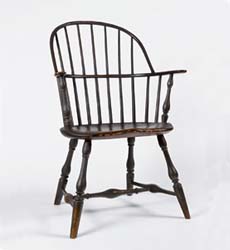 |
| Figure 34 Joseph Henzey, armchair, Philadelphia, Pennsylvania, ca. 1785. Unidentified ring-porous hardwoods, unidentified softwood, and maple. H. 37 3/4", W. 21 3/4" (seat), D. 16" (seat); seat height: 17 3/4"; seat depth/seat width: .736; rounded rail width: .919"; rail thickness: .703"; arm support angle: 5°. (Courtesy, Independence National Historic Park; photo, Gavin Ashworth.) Henzey’s Windsors are known for long baluster turnings, short tapered feet, and finely shaped seats, but structural analysis indicates that his chairs are weaker because their arm rails are rounded and arm support angles are weak. Since Henzey did not set up a large shop until after the Revolution, this chair and others suggest that he was using weaker construction methods after the war. |